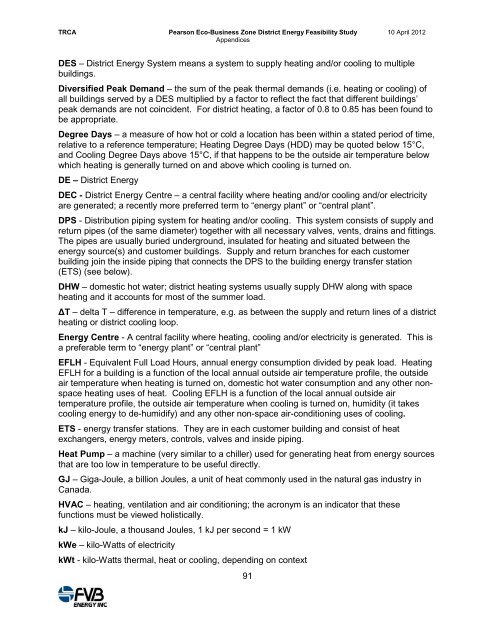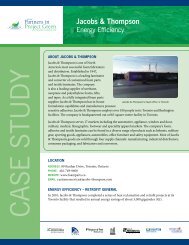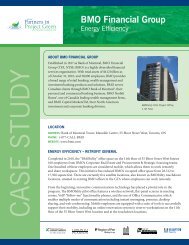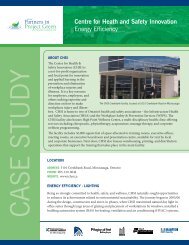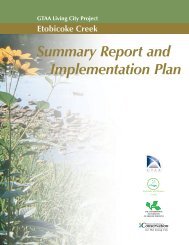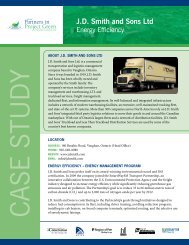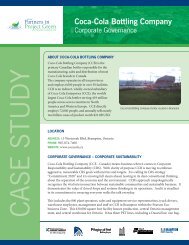Project Green District Energy Feasibility Study - Partners in Project ...
Project Green District Energy Feasibility Study - Partners in Project ...
Project Green District Energy Feasibility Study - Partners in Project ...
Create successful ePaper yourself
Turn your PDF publications into a flip-book with our unique Google optimized e-Paper software.
TRCA Pearson Eco-Bus<strong>in</strong>ess Zone <strong>District</strong> <strong>Energy</strong> <strong>Feasibility</strong> <strong>Study</strong> 10 April 2012<br />
Appendices<br />
DES – <strong>District</strong> <strong>Energy</strong> System means a system to supply heat<strong>in</strong>g and/or cool<strong>in</strong>g to multiple<br />
build<strong>in</strong>gs.<br />
Diversified Peak Demand – the sum of the peak thermal demands (i.e. heat<strong>in</strong>g or cool<strong>in</strong>g) of<br />
all build<strong>in</strong>gs served by a DES multiplied by a factor to reflect the fact that different build<strong>in</strong>gs’<br />
peak demands are not co<strong>in</strong>cident. For district heat<strong>in</strong>g, a factor of 0.8 to 0.85 has been found to<br />
be appropriate.<br />
Degree Days – a measure of how hot or cold a location has been with<strong>in</strong> a stated period of time,<br />
relative to a reference temperature; Heat<strong>in</strong>g Degree Days (HDD) may be quoted below 15°C,<br />
and Cool<strong>in</strong>g Degree Days above 15°C, if that happens to be the outside air temperature below<br />
which heat<strong>in</strong>g is generally turned on and above which cool<strong>in</strong>g is turned on.<br />
DE – <strong>District</strong> <strong>Energy</strong><br />
DEC - <strong>District</strong> <strong>Energy</strong> Centre – a central facility where heat<strong>in</strong>g and/or cool<strong>in</strong>g and/or electricity<br />
are generated; a recently more preferred term to “energy plant” or “central plant”.<br />
DPS - Distribution pip<strong>in</strong>g system for heat<strong>in</strong>g and/or cool<strong>in</strong>g. This system consists of supply and<br />
return pipes (of the same diameter) together with all necessary valves, vents, dra<strong>in</strong>s and fitt<strong>in</strong>gs.<br />
The pipes are usually buried underground, <strong>in</strong>sulated for heat<strong>in</strong>g and situated between the<br />
energy source(s) and customer build<strong>in</strong>gs. Supply and return branches for each customer<br />
build<strong>in</strong>g jo<strong>in</strong> the <strong>in</strong>side pip<strong>in</strong>g that connects the DPS to the build<strong>in</strong>g energy transfer station<br />
(ETS) (see below).<br />
DHW – domestic hot water; district heat<strong>in</strong>g systems usually supply DHW along with space<br />
heat<strong>in</strong>g and it accounts for most of the summer load.<br />
ΔT – delta T – difference <strong>in</strong> temperature, e.g. as between the supply and return l<strong>in</strong>es of a district<br />
heat<strong>in</strong>g or district cool<strong>in</strong>g loop.<br />
<strong>Energy</strong> Centre - A central facility where heat<strong>in</strong>g, cool<strong>in</strong>g and/or electricity is generated. This is<br />
a preferable term to “energy plant” or “central plant”<br />
EFLH - Equivalent Full Load Hours, annual energy consumption divided by peak load. Heat<strong>in</strong>g<br />
EFLH for a build<strong>in</strong>g is a function of the local annual outside air temperature profile, the outside<br />
air temperature when heat<strong>in</strong>g is turned on, domestic hot water consumption and any other nonspace<br />
heat<strong>in</strong>g uses of heat. Cool<strong>in</strong>g EFLH is a function of the local annual outside air<br />
temperature profile, the outside air temperature when cool<strong>in</strong>g is turned on, humidity (it takes<br />
cool<strong>in</strong>g energy to de-humidify) and any other non-space air-condition<strong>in</strong>g uses of cool<strong>in</strong>g.<br />
ETS - energy transfer stations. They are <strong>in</strong> each customer build<strong>in</strong>g and consist of heat<br />
exchangers, energy meters, controls, valves and <strong>in</strong>side pip<strong>in</strong>g.<br />
Heat Pump – a mach<strong>in</strong>e (very similar to a chiller) used for generat<strong>in</strong>g heat from energy sources<br />
that are too low <strong>in</strong> temperature to be useful directly.<br />
GJ – Giga-Joule, a billion Joules, a unit of heat commonly used <strong>in</strong> the natural gas <strong>in</strong>dustry <strong>in</strong><br />
Canada.<br />
HVAC – heat<strong>in</strong>g, ventilation and air condition<strong>in</strong>g; the acronym is an <strong>in</strong>dicator that these<br />
functions must be viewed holistically.<br />
kJ – kilo-Joule, a thousand Joules, 1 kJ per second = 1 kW<br />
kWe – kilo-Watts of electricity<br />
kWt - kilo-Watts thermal, heat or cool<strong>in</strong>g, depend<strong>in</strong>g on context<br />
91


